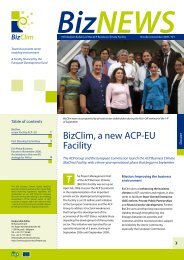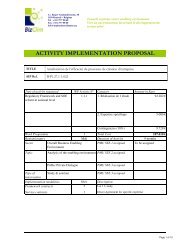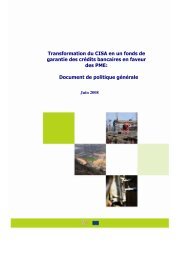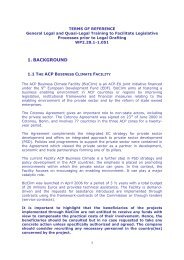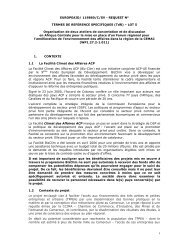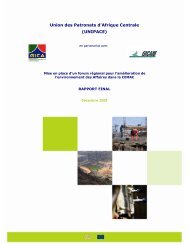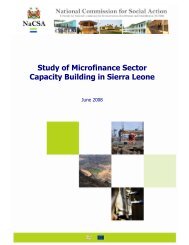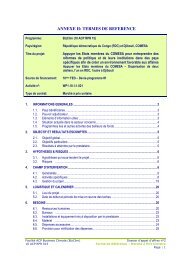(PPP) for Swaziland - ACP Business Climate
(PPP) for Swaziland - ACP Business Climate
(PPP) for Swaziland - ACP Business Climate
Create successful ePaper yourself
Turn your PDF publications into a flip-book with our unique Google optimized e-Paper software.
3. Service specifications: There are several ways to<br />
specify the <strong>PPP</strong> services and facilities. Services and<br />
facilities specifications are generally expressed as<br />
outputs. There are also specific outputs not directly<br />
related to the overall service (<strong>for</strong> example, a clinic<br />
to be constructed on the hospital grounds which<br />
is to be operated by another party). Input specifications<br />
should be kept to a minimum as they may<br />
affect operational efficiency or impact excessively<br />
on the design of the facility. Where the assets revert<br />
to the Government entity they must be in a<br />
specified condition, which dictates replacement and<br />
maintenance cycles as well as financial assumptions<br />
such as residual value and depreciation (conditionsof-asset-specifications)<br />
4. Standard specifications: The RFP must apply objective<br />
standards which are measurable and consistent<br />
with best practice.<br />
5. Payment mechanism and penalty regime: There must<br />
be a unitary payment arrangement including a single,<br />
indivisible unitary payment <strong>for</strong> full availability and<br />
per<strong>for</strong>mance of the services, an appropriate indexation,<br />
a mechanism <strong>for</strong> penalising partial or complete<br />
failure of the availability and per<strong>for</strong>mance of the service<br />
(by means of penalty deductions, a mechanism<br />
<strong>for</strong> dealing with changes to service requirements.<br />
6. Legal requirements and draft <strong>PPP</strong> agreement: These<br />
are all the key commercial and per<strong>for</strong>mance requirements<br />
necessary to sign off that the consortium<br />
has the legal status and capacity to fulfil the requirements<br />
of the <strong>PPP</strong> agreement, including shareholding<br />
agreements, corporate governance requirements<br />
and full disclosure of the consortium makeup. The<br />
RFP must include a draft <strong>PPP</strong> agreement that allows<br />
<strong>for</strong> highly structured bidder input.<br />
7. Commitments required from bidders are a crucial<br />
part of RFP (security requirements, liquidated damages,<br />
contents of the financial models).<br />
8. Evaluation criteria: Broad categories of evaluation,<br />
but in sufficient detail to focus bidders’ attention on<br />
the value-<strong>for</strong>-money areas.<br />
9. Bid <strong>for</strong>malities<br />
Choosing the Preferred Bidder<br />
It would be too costly to make all bidders draft a complete<br />
design etc. So there will always be some outstanding<br />
issues with the chosen bidder, <strong>for</strong> example, finalising<br />
design, obtaining full planning clearance, etc.<br />
Syndicate group work on Case study 1<br />
(<strong>Swaziland</strong> <strong>PPP</strong> Implementation Guidelines, p. 27)<br />
1. Questions // Will it preferable <strong>for</strong> government to<br />
pay monthly or annually? What option will the<br />
bidder prefer? If you chose monthly, will it offer<br />
any discount?<br />
The government prefers to pay annually as it has<br />
an annual budget and it has less administrative<br />
costs. The fiscal position might not be known and<br />
may be variable, so monthly payment take away<br />
money from other government obligation. For<br />
the bidder, monthly payments are usually preferable<br />
because of the cash flow (payment obligations<br />
to banks/employees, opportunity to reinvest,<br />
reduced risk of inflation, etc.). In summary,<br />
a monthly payment structure is usually preferred.<br />
But in this case the private sector should offer a<br />
discount as it has several advantages.<br />
2. How will cost escalation be handled? Is it simply<br />
an index linked <strong>for</strong>mula, or will the cost of buildings<br />
be recovered as fixed annuity, while operations<br />
are index-linked? How will the maintenance<br />
cost be handled – on actual cost basis?<br />
The fixed annuity method should be applied <strong>for</strong><br />
building costs and the variable method that is based<br />
on price index <strong>for</strong> maintenance and operation.<br />
17




